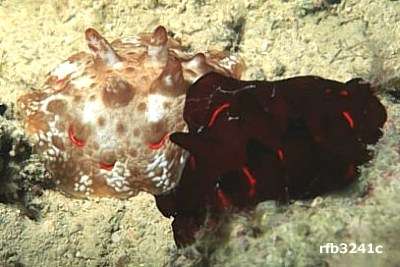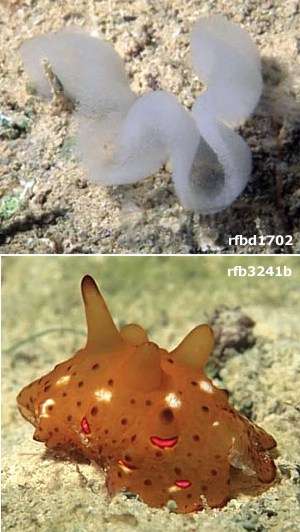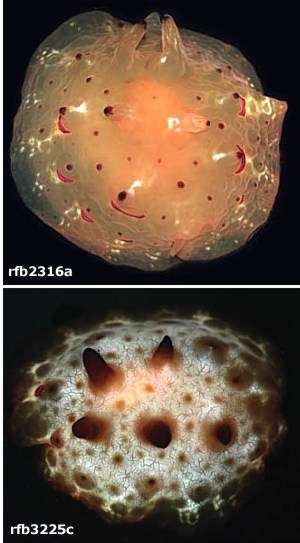Pleurobranchus mamillatus from Okinawa
May 4, 2000
From: Bob Bolland

Hi Bill,
In response to a recent P. mamillatus post in the Slug Forum, I thought I'd send some images and general information on the Okinawan material.
I found what I believe to be the end of a mass spawning. I found the initial lone animal on 18 February, 1990; on 14 & 15 March, 1990, scores of ova were found in the general area (although no animals were actually seen on the eggs). The accompanying photo is typical of the numerous ova found at this time. Many of the animals appeared to be moribund and were observed to have wounds which appeared to have been predator-inflicted(?). Perhaps as many as 25 animals were seen on the 14th and 15th of March. I've only found a few others since then up to the present time.
All of these animals were seen at one specific dive site, Seragaki, Okinawa; one specimen was found on open sand, all others, including the ova, were found amid mixed sand and strewn coral rubble. The animals were all found within an approximate spread of perhaps fifty meters and a 37m ~ 49m depth range. There was relatively little consistency in color of these attractive animals. The observed colors were a very light gray, mottled gray, light tan, dark brown, and black; many of the individuals had prominent dorsal projecting papillae and all had a consistently brightly colored lunate pattern on the notum.
Slide Data:
D-1702-14: Ova, size not recorded / 37m
rfb2316: 145mm / 43m
rfb3241b: 66mm / 37m
rfb3241c: 77mm, [second animal in photo not measured or collected / 37m]
rfb3225c: 70mm / 47m
Cheers,
Bob
bollandr@rapid-link.ne.jp


Dear Bob,
Thanks for the photos and information. Two general points it raises is 'mass events' such as mass mortality, mass spawning etc., and predation.
We normally associate 'mass events' with Sea Hares but I am sure we all can remember a few occasions when we have witnessed an event such as you describe for P. mamillatus. I can remember in Tanzania on one occasion [lasted about a month] where shallow reef flat was a mass of large Pleurobranchus forskalii. I had never seem them in such numbers before or since. And Scott Johnson's message about Gymnodoris ceylonica reports a similar 'mass' event. I guess the other think to realise is that population explosions like this are commonplace among small sea slugs like sacoglossans, aeolids etc. They only seem special when the animals involved are large.
While mass events in Sea Hares are a fairly normal part of the life cycle, in large pleurobranchs and nudibranchs they seem to be rare events, probably occurring through a lucky combination of normal events.
The other interesting point you raise is possible evidence of predation by something unknown. One big gap in our knowledge is what actually eats Sea Slugs. Except in rare cases such information, where it exists, is published not in the malacological literature, where we would look, but in the literature associated with predator, for example fish biology journals. Another example of mine about Pleurobranchus forskalii in Tanzania, illustrates this problem. In desperation a visiting turtle specialist asked me to look at some strange chitinous plates from the stomach contents of turtles which he had been unable to identify.
They were the jaw plates of large pleurobranchs, probably Pleurobranchus forskalii. This information was published in some report known to turtle biologists but is effectively lost to malacology. I think this is a good time to add a page for predation records where we can gradually accumulate such information on who/what eats sea slugs. any records/observations would be appreciated.
Best wishes,
Bill Rudman.
Related messages
-
Pleurobranchus mamillatus from Lakshadweep, India
From: Apte Deepak, April 30, 2010 -
Pleurobranchus mamillatus from South Africa
From: Neil Wiltshire, March 3, 2010 -
Juvenile Pleurobranchus mamillatus from Indonesia
From: Danny Van Belle, March 15, 2007 -
Pleurobranchus mamillatus from Indonesia
From: Hendra Tan, April 8, 2006 -
Pleurobranchus mamillatus from Eilat, Israel
From: Albert Baranes, February 24, 2006 -
Pleurobranchus mamillatus from Zanzibar
From: Carlos Martínez-Escamilla, October 31, 2005 -
Another form of Pleurobranchus mamillatus
From: Dong Bum Koh, August 22, 2005 -
Pleurobranchus mamillatus from Sth Korea
From: Dong Bum Koh, August 19, 2005 -
Pleurobranchus mamillatus from Indonesia
From: Erwin Koehler, October 1, 2003 -
Pleurobranchus mamillatus from Anilao
From: Ray Izumi, July 13, 2003 -
Pleurobranchus mamillatus? from Japan
From: Yoshinori Fukuyo, May 22, 2003 -
Re: Pleurobranchus mamillatus from Papua New Guinea
From: Ray Izumi, May 3, 2000 -
Pleurobranchus mamillatus from Papua New Guinea
From: Ray Izumi, May 1, 2000
